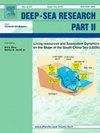Assessment of oceanographic characteristics and water mass exchange in the Persian Gulf and Gulf of Oman
IF 3
3区 地球科学
Q2 OCEANOGRAPHY
Deep-sea Research Part Ii-topical Studies in Oceanography
Pub Date : 2025-06-16
DOI:10.1016/j.dsr2.2025.105503
引用次数: 0
Abstract
Physical oceanography of the Persian Gulf (PG), Strait of Hormuz (SH), and Gulf of Oman (GO) waters is poorly understood, necessitating more extensive and long-term studies. The main goal of this research is to comprehend the oceanographic properties and water mass exchange in this region. The study evaluates the range and patterns of the changes in physical characteristics (salinity (S), temperature (T), and depth (D or pressure, P)) and structure, mixing and stratification, and circulation of water in the PG, SH and GO. The findings revealed that the maximum recorded sea surface temperature in the PG exceeded than that in the GO during the summer. Seawater temperature in the PG decreased from east to west in the winter. The maximum sound speed values were in the surface layer during the summer (approximately 1557.5 m/s). The maximum salinity gradient and winter halocline were found between depths of 40 and 60 m. The vertical structure of seawater indicates the formation of strong thermal and density stratifications in the summer. The Richardson Number (Ri No.) in the SH ranged from in the summer and it varied between during the winter. A dense water mass with a salinity more than 40 psμ (originating from the PG) was found below 150 m depth in the southwestern part of the GO. The stability and layering of the water column in the SH are under effect of the two-layer currents and the movement of water masses between the PG and GO. The static stability number (E) of the water column in the eastern part of the PG varied in the range of during the winter, and between in the summer. The maximum amount of the density anomaly occurs in the deep areas of the PG during the summer. During the winter, a two-layered water structure forms in the central areas of the SH. Horizontal and vertical gradients of the salinity and density facilitate the exchange of water masses between the PG and the GO through the SH. The average flushing time (Residence Time, TResidence) of the PG is 1.82 years. The findings of the study offer an observational evaluation of the water mass exchange, seawater parameters, stratification, and variations in sound speed. It is recommended continuing the study with additional sampling stations, particularly in the southern part of the PG, and conducting flow measurements in the SH.
波斯湾和阿曼湾海洋特征和水团交换的评估
对波斯湾(PG)、霍尔木兹海峡(SH)和阿曼湾(GO)水域的物理海洋学了解甚少,需要更广泛和长期的研究。本研究的主要目的是了解该地区的海洋学性质和水团交换。该研究评估了PG、SH和GO的物理特征(盐度(S)、温度(T)和深度(D或压力,P)、结构、混合和分层以及水的循环变化的范围和模式。结果显示,夏季太平洋的最高记录海表温度高于印度洋的最高记录海表温度。冬季PG海水温度自东向西降低。夏季声速最大值出现在表层,约为1557.5 m/s。最大盐度梯度和冬季盐跃层出现在深度40 ~ 60 m之间。海水垂直结构表明夏季形成了强烈的热分层和密度分层。夏季SH的理查德森数(Ri No)在0.5<RiNo.<;0.65之间,冬季在0.03<RiNo.<;0.15之间变化。在GO西南部150 m深度以下发现了盐度大于40 psμ的致密水团(来自PG)。浅海水柱的稳定和分层是受两层流和水团在浅海和浅海之间运动的影响。冬季PG东部水柱静态稳定数(E)在3×10−4<;E<;6×10−4范围内变化,夏季在12×10−4<;E<;16×10−4范围内变化。密度异常的最大量出现在夏季的太平洋深部。在冬季,浅海中部形成两层水结构。盐度和密度的水平和垂直梯度有利于浅海与氧化石墨酸之间的水团通过浅海交换。浅海的平均冲洗时间(Residence time, Residence)为1.82年。研究结果提供了对水质量交换、海水参数、分层和声速变化的观测评价。建议在额外的采样站继续研究,特别是在PG的南部,并在SH进行流量测量。
本文章由计算机程序翻译,如有差异,请以英文原文为准。
求助全文
约1分钟内获得全文
求助全文
来源期刊
CiteScore
6.40
自引率
16.70%
发文量
115
审稿时长
3 months
期刊介绍:
Deep-Sea Research Part II: Topical Studies in Oceanography publishes topical issues from the many international and interdisciplinary projects which are undertaken in oceanography. Besides these special issues from projects, the journal publishes collections of papers presented at conferences. The special issues regularly have electronic annexes of non-text material (numerical data, images, images, video, etc.) which are published with the special issues in ScienceDirect. Deep-Sea Research Part II was split off as a separate journal devoted to topical issues in 1993. Its companion journal Deep-Sea Research Part I: Oceanographic Research Papers, publishes the regular research papers in this area.

 求助内容:
求助内容: 应助结果提醒方式:
应助结果提醒方式:


